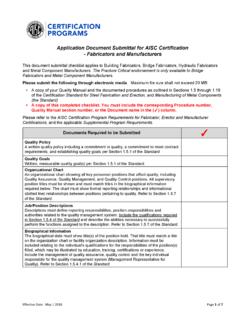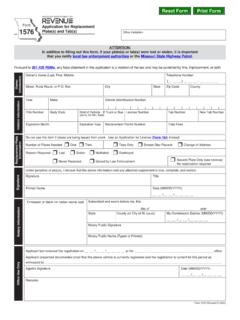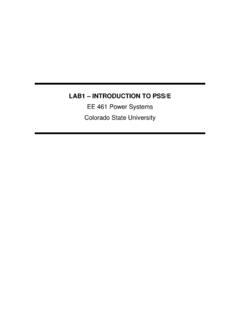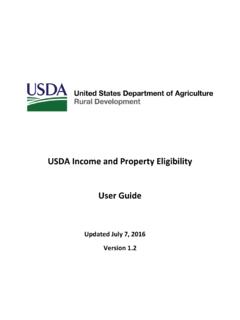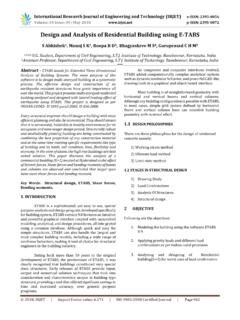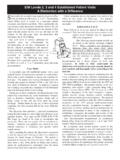Transcription of steelwise Keeping tabs on ASTM specifications aRE yOU ...
1 MODERN STEEL CONSTRUCTION february 2012 ThE MaTERIaLS aND pRODUCTS used in building design and construction are almost universally designated by refer-ence to an appropriate ASTM specification. This simplifies the design and construction process because you can define all the characteristics of a specified product. However, with dozens of ASTM specifications applicable in steel building construction alone it can be a challenge to keep the standard designations used in contracts article provides a summary of the common ASTM specifications used in steel building design and construction, including structural shapes, plate products, fastening products, and other products. This information is based on similar and more extensive information in the 14th Edition AISC Steel Construction Manual.
2 You may also find it convenient to use the AISC publication Selected ASTM Standards for Structural Steel Fabrication, a compilation of more than 60 steel-related ASTM standards. (Both the AISC Manual and Selected ASTM Standards are available for purchase online at )Note that ASTM standards routinely include a section on ordering requirements that lists the variables in each standard that should be specified in a complete order or specification for the material. This is routine for the purchasing department at the local fabrication company, and may be of great interest to others as ShapesSee Summary in Table 1. W-ShapesThe preferred material specification for W-shapes is ASTM A992 (Fy = 50 ksi, Fu = 65 ksi). The availability of W-shapes in grades other than ASTM A992 should be confirmed prior to their specification.
3 W-shapes with higher yield and tensile strength can be obtained by specifying ASTM A572 Grade 60, or 65, or ASTM A913 Grades 60, 65 or with atmospheric corrosion resistance (weather-ing characteristics) can be obtained by specifying ASTM A588 Grade 50 or ASTM A242 Grade 42, 46 or 50. Other mate-rial specifications applicable to W-shapes include ASTM A36, ASTM A529 Grade 50 and 55, ASTM A572 Grade 42 and 50, and ASTM A913 Grade 50. M-Shapes and S-ShapesThe preferred material specification for M-shapes is in tran-sition. ASTM A36 (Fy = 36 ksi, Fu = 58 ksi) remains common, but 50 ksi grades increasingly are being used, including ASTM A572 Grade 50, ASTM A529 Grade 50 or ASTM A992; each of these 50 ksi grades has Fy = 50 ksi and Fu = 65 ksi for these shapes. The availability of M-shapes in grades other than A36 should be confirmed prior to their with a higher yield and tensile strength can be obtained by specifying ASTM A572 Grades 55, 60 and 65, ASTM A529 Grade 55, or ASTM A913 Grades 60, 65 or 70.
4 M-shapes with atmospheric corrosion resistance (weathering characteristics) can be obtained by specifying ASTM A588 Grade 50 or ASTM A242 Grade 50. Other material specifica-tions applicable to M- and S-shapes include ASTM A529 Grade 42, ASTM A572 Grade 42 and ASTM A913 Grade 50. ChannelsThe preceding comments for M-shapes apply equally to the MC12 that appears in the current ASTM A6 listing of standard shapes. Think of this new channel shape as a stair stringer it has a 21 8-in. flange width, which is wide enough to accept the handrail pipe and fillet weld around it. HP-ShapesThe preferred material specification for HP shapes is ASTM A572 Grade 50 (Fy = 50 ksi, Fu = 65 ksi); the availability of other grades should be confirmed prior to with atmospheric corrosion resistance (weathering characteristics) can be obtained by speci-fying ASTM A588 Grade 50 or ASTM A242 Grades 46 or 50.
5 Other material specifications applicable to HP-shapes include ASTM A36, ASTM A529 Grades 50 or 55, ASTM A572 Grades 42, 55, 60 and 65, ASTM A913 Grades 50, 60, 65 and 70, and ASTM the new HP18- and HP16-series shapes that have been added to ASTM yOU pROpERLy SpECIfyINg MaTERIaLS?by Martin anderson and Charles J. Carter, , , tabs on ASTM specifications will help you make the right steel shape choices when designing and building your anderson is coordinator of aisC s steel solutions Center. Charles J. Carter, , , , is vice president and chief structural engineer at aisC. february 2012 MODERN STEEL CONSTRUCTION AnglesThe preferred material specification for angles is in transi-tion. ASTM A36 (Fy = 36 ksi, Fu = 58 ksi) remains common, but 50 ksi grades increasingly are being used, including ASTM A572 Grade 50, ASTM A529 Grade 50 or ASTM A992; each of these 50 ksi grades has Fy = 50 ksi and Fu = 65 ksi.
6 The avail-ability of angles in grades other than ASTM A36 should be con-firmed prior to their with higher yield and tensile strength can be obtained by specifying ASTM A572 Grades 55, 60 or 65, ASTM A529 Grade 55 and ASTM A913 Grades 60, 65 or 70. Angles with atmospheric corrosion resistance (weathering characteristics) can be obtained by specifying ASTM A588 Grade 50 or ASTM A242 Grades 46 or 50. Other material specifications applicable to angles include ASTM A529 Grade 42, ASTM A572 Grade 42 and ASTM A913 Grade 50. Structural TeesStructural tees are split from W-, M- and S-shapes to make WT-, MT- and ST-shapes respectively. For the preferred mate-rial specifications , as well as other suitable material specifica-tions for structural tees, refer to the preceding sections on W-, M- or S-shapes as appropriate.
7 Rectangular (and Square) HSSThe preferred material specification for rectangular hollow structural sections (HSS) is ASTM A500 Grade B (Fy = 46 ksi, Fu = 58 ksi), although ASTM A500 Grade C (Fy = 50 ksi, Fu = 62 ksi) is very common. The availability of rectangular HSS in grades other than ASTM A500 Grade B should be confirmed prior to their HSS with atmospheric resistance (weathering characteristics) can be obtained by specifying ASTM A847. Other material specifications applicable to rectangular HSS include ASTM A501 Grades A and B and ASTM A618. Round HSSThe preferred material specification for round HSS is ASTM A500 Grade B (Fy = 42 ksi, Fu = 58 ksi), although ASTM A500 Grade C (Fy = 46 ksi, Fu = 62 ksi) is very common. The avail-ability of round HSS in grades other than ASTM A500 Grade B should be confirmed prior to specification.
8 Generally speaking, only round HSS with the same cross-sectional dimensions as table 1applicable aSTM specifications for Various Structural Shapessteel typeastM designationFy Min. yield stress (ksi)Fu tensile stressa (ksi)applicable shape 80ba53 Gr. b3560a500Gr. b42584658Gr. C46625062a501Gr. a3658Gr. b5070a529cGr. 505065 100Gr. 555570 100high-strength low-alloya572Gr. 424260Gr. 505065dGr. 555570Gr. 60e6075Gr. 65e6580a618fGr. i & ii50g70gGr. iii5065a9135050h60h606075656580707090a99 250 65i65iCorrosion resistant high-strength low-alloya24242j63j46k67k50l70la5885070a 8475070a Minimum unless a range is for shapes over 426 lb/ft, only the minimum of 58 ksi for shapes with a flange thick-ness less than or equal to in. only. to improve weldability a maximum carbon equivalent can be specified (per astM supple-mentary requirement s78).
9 If desired, maximum tensile stress of 90 ksi can be specified (per astM supplementary require-ment s79).d if desired, maximum tensile stress of 70 ksi can be specified (per astM supplementary re-quirement s91).e for shapes with a flange thick-ness less than or equal to 2 in. astM a618 can also be speci-fied as corrosion-resistant; see astM Minimum applies for walls nomi-nally -in. thick and under. for wall thicknesses over in., Fy = 46 ksi and Fu = 67 if desired, maximum yield stress of 65 ksi and maximum yield-to-tensile strength ratio of can be specified (per astM supple-mentary requirement s75).i a maximum yield-to-tensile strength ratio of and carbon equivalent formula are included as mandatory in astM for shapes with a flange thick-ness greater than 2 in. for shapes with a flange thick-ness greater than in.
10 And less than or equal to 2 in. for shapes with a flange thickness less than or equal to in. material applicable material specification, the availability of which should be confirmed prior to specification does not apply. MODERN STEEL CONSTRUCTION february 2012steel pipe are stocked and available. See the sidebar below 12 Tidbits for further HSS with atmospheric corrosion resistance (weath-ering characteristics) can be obtained by specifying ASTM A847. Other material specifications applicable to round HSS include ASTM A501 Grades A and B and ASTM A618. Steel PipeThe material specification for steel pipe used in structural frames is ASTM A53 Grade B (Fy = 35 ksi, Fu = 60 ksi). In some regions, ASTM A53 material is more readily available than ASTM A500 for round cross-sections. See the sidebar 12 Tid-bits for further productsSee Summary in Table 2.




